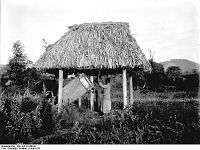Ngoma drums

Ngoma (also called engoma or ng'oma or ingoma) are musical instruments used by certain Bantu populations of Africa. Ngoma is derived from the Kongo word for "drum". Different Bantu-inhabited regions have their own traditions of percussion, with different names for their instruments. In Kikongo, "ngoma" is used by extension to signify specific dances, social occasions and rhythms.
Use in the Great Lakes and Southern Africa
The ngoma drum is known as engoma throughout the African Great Lakes region. In Swahili, ngoma resulted because of unease in pronouncing engoma by dropping the syllable e.
The Banyankore hold drums in high regard; especially the royal drums headed by Bagyendanwa, without which a prince never laid claim to kingship.
The Baganda of Uganda have a special relationship with ngoma drums, so much so that it is thought by many people that theirs is the country where this type of drum actually originated. The Baganda are fondly thought of as the children of Ngoma. The ngoma is used for communication and celebration and is also a symbol of authority.
The ngoma are made of wood, which is covered with cow skin pegged on both ends, although you’ll also find tourist versions of these drums covered with zebra skins. Typically, they are played in groups of seven drums, each drum having its own voice and function within the ensemble. Another popular configuration is made with at least four drums. Each of these drums are treated as individuals, thus they each have a specific name. The largest drum is known as bakisimba and makes a loud bass sound. The empuunya is a little smaller and also produces a higher-pitched bass sound. The nankasa is a small drum played with sticks and produces a very high-pitched sound. Last, but not least is the engalabi. The engalabi most closely resembles the original ngoma and is taller and more cylindrical than all the other drums in this set. It also has skin on only one side. All of the other drums are covered with cow skin on the top and bottom using an intricate lacing system, whereas the engalabi has a lizard-skin head attached with small wooden pegs. This drum makes the highest pitched sound in the ensemble.
Throughout Central and South Africa, ngoma ceremonies are used to assist in healing during ceremonies. The rituals involve rhythmic music and dance, and can result in “stress reduction, social support, support of prosocial behaviors, psychodynamic growth, and placebo effect”.[1] Ngoma often serves as a tool to unify the tribe, and assist in health or life transitions. The ngoma drum is also used in Zimbabwe, mainly for traditional dances and celebrations.
All of the drums can be played with sticks or hands, except the Nankasa which is primarily played with sticks. The Children of Uganda, AIDS orphans from the Daughters of Charity Orphanage, have been touring the world biennially since 1996 and are the most representative proponents abroad of the music of Uganda. Their music and dance presentations reveal the cultural traditions of their country, as well as the trials and travails of modern life in the African Great Lakes today. They play a variety of traditional local instruments, including ngoma, amadinda (marimba or xylophone), obuuti (sticks for amadinda and ngoma), akogo (marimba- or kalimba-type instrument), adungu (bow harp or lute), edinqiri (tube fiddle), endere (pan pipe).
References
- Mutwa, Credo Vusa'mazulu: My People, My Africa, New York: John Day (1969).
- Mutwa, Credo Vusa'mazulu: Indaba My Children: African Folktales, Grove Press (1964).
- University Musical Society's Youth Education Program: "Children of Uganda Teacher Resource Guide" by Bree Juarez. Edited by Bree & Ben Johnson (2005).
- Berliner, Paul. (1978). The Soul of Mbira: music and traditions of the Shona people of Zimbabwe. Berkeley: University of California Press.
- Howard, Joseph H. (1967). Drums in the Americas. New York: Oak Publications.
- Mutwa, Credo Vusa'mazulu. (1969). My People: the incredible writings of Credo Vusa'mazulu Mutwa. Johannesburg : Blue Crane Books, 1969.
- Tracey, Andrew. (1970). "The Matepe Mbira Music of Rhodesia". Journal of the African Music Society, IV: 4, 37-61.
- Tracey, Andrew. (1970). How to Play the Mbira (dza vadzimu). Roodepoort, Transvaal, South Africa: International Library of African Music.
- Tracey, Hugh. (1961). The Evolution of African Music and its Function in the Present Day. Johannesburg: Institute for the Study of Man in Africa.
- Tracey, Hugh. (1969). "The Mbira class of African Instruments in Rhodesia" (1932). African Music Society Journal, 4:3, 78-95.
Recordings
- Columbia Records: Drums of Passion. Liner notes by Akinsola Akiwowo (1958).
External links
- The Children of Uganda detailed study guide
- a page from Indaba My Children: African Folktales where the creation of ngoma is described
- "The Queen's Gift" by Bethan Lewis
- Royal Museum for Central Africa: Ingoma (drum)